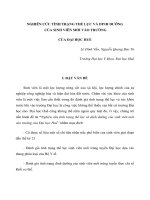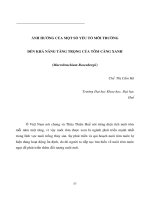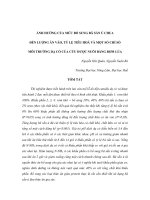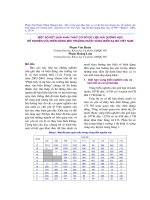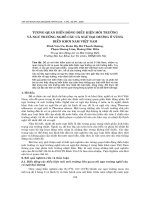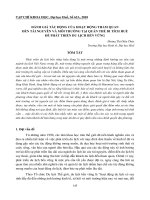Báo cáo nghiên cứu khoa học: "Môi trường làm việc nguy hiểm cho các rối loạn cơ xương trong số các nhân viên văn phòng trường đại học ở Khonkaen, Thái Lan" pps
Bạn đang xem bản rút gọn của tài liệu. Xem và tải ngay bản đầy đủ của tài liệu tại đây (53.93 KB, 9 trang )
11
JOURNAL OF SCIENCE, Hue University, N
0
61, 2010
WORK ENVIRONMENT HAZARDS FOR MUSCULOSKELETAL
DISORDERS AMONG UNIVERSITY OFFICE WORKERS IN KHONKAEN,
THAILAND
Sunisa Chaiklieng, Pornnapa Suggaravetsiri, Yodchai Boonprakob
Khon Kaen University, Thailand
SUMMARY
Introduction: Musculoskeletal disorders are commonly found in office workers,
however, it is unclear if work environment factors related to musculoskeletal disorders are
common among University officers. This cross-sectional analytical study is aimed at
investigating environmental hazards in workplaces for musculoskeletal disorders among
University office workers. Methods: 142 participants who were full time University office staff
from Khon Kaen University. Demographic characteristics and musculoskeletal disorders were
evaluated from structural questionnaires. Anthropometric parameters were determined and
ergonomic workstations and illuminations were measured at workstations. Descriptive statistics
were percentages, means, and standard deviations (SD). Inferential statistics were chi-square
test and the student t-test at 95% confidence interval. Results: The results showed that 81.7% of
office workers were female, the mean age was 38.0+10.0 years, the average work experience
was 12.3+10.8 years. The one-month prevalence of musculoskeletal disorders was 69.0%. The
onset of symptoms was during working hours and the majority of self-reported causes was
prolonged sitting in the same posture at work (73.3%). Light intensities were lower than the
minimum standard requirement (400 lux) for 55.8% workstations. Most workstations (75.6%)
had significantly inappropriate height (above elbow height of workers). Moreover, the
anthropometric characteristics of musculoskeletal disorders cases were significantly different
from healthy office workers (p-value<0.05) i.e. popliteal height, buttock-popliteal length, hip
breadth, sitting elbow height. Conclusions: The findings suggest that ergonomic workstations
need to be improved appropriately for individual workers and improvements of working
conditions following the standard requirements, which should be considered.
Keywords: musculoskeletal disorders, office workers, ergonomics, environment
1. Introduction
Persistant musculoskeletal disorders are common in society. 70-85% of all
people have low-back pain at some time in life. The annual prevalence of back pain
ranges from 15% to 45% with a point prevalence averaging 45%. Neck and shoulder
12
disorders are prevalent among both women and men. It has been reported that the
prevalence of neck or shoulder pain in office workers is much higher than in the general
population. Previous studies showed that a one year prevalence of neck pain in office
workers at Hong Kong University was found to be 59% and 63% in a Swedish study of
medical secretaries. One year prevalence of low back pain among Greek public office
workers was 37.8%. Back pain prevalence in academic personnel was 21.8% among
school personnel in Nagoya, Japan. Many studies have investigated the relationship
between musculoskeletal disorders and risk factors in working conditions. Postulated
factors in the occupation group include: individual factors, anthropometric and
ergonomic factors (workstations and instruments, lifting, repetitive work), physical
factors (prolonged sitting, awkward posture, twisting and bending of the trunk),
psychosocial factor i.e. stress and perceived muscular tension. While prevalence of back
pain is quite high in university office workers, it is unclear if work environment factors
relate to musculoskeletal disorders. Therefore, the aim of this study was to investigate
work environment hazards in office workplaces related to musculoskeletal disorders
among university officers.
2. Methodology
This study was designed as a cross-sectional analytic investigation of 142
university office staff (116 women and 26 men). The participants were invited and
interviewed before entering the study. They were considered eligible for inclusion in
this study if they were a full-time university employee and had at least one-year
working experience at the current position. Participants were excluded if they had
chronic musculoskeletal diseases or injuries affecting cervical, thoracic or lumbar spine,
renal dysfunction, or unwillingness to participate. Participants were interviewed by
using the structural questionnaires dealing with individual factors, musculoskeletal
disorders and the onset of symptoms, and working environments. Here we define
musculoskeletal disorders as pain experienced in the spine area or more specifically
between the inferior angle of the scapula and the gluteal folds, or between the buttocks
and the vertebrae prominence applied from Maniadakis and Gray. Participants reported
the region of pain by putting X on the area at body chart (drawing) where he/she feel
pain.
The body weight, height, waist circumference (WC) and anthropometric
characteristics were measured using standardized procedures with established reliability.
Measured parameters were determined for popliteal height, hip breadth, buttock-
popliteal-length, sitting shoulder height, sitting elbow height and elbow height. Waist
circumferences which were greater than 80 cm among women and 90 cm among men
identified obesity. To investigate work environment factors (ergonomic factors and
illuminations), Data logging light meter (model: 401036 version 2.3 11/13, range 20-
200000, Extech Instruments) was used to measure the lighting at 129 work stations
13
during working hours. Illumination data were evaluated by comparing to the standard
requirement of general office workplace at 400 lux. The dimensions of table, seat and
work area were evaluated from 131 workstations using steel measuring tape.
Statistical analysis
All analyses were performed using STATA version 8.2, Texas, USA. 2007. The
percentage of musculoskeletal disorders and other parameters were calculated as a
proportion. Descriptive statistics were percentages, means and standard deviations (SD).
The associations between musculoskeletal disorders and studied factors were identified
by using chi-square test and student t-test at 95% confidence interval. This study was
approved by the appropriated institutional ethical review committee, Khon Kaen
University, Thailand.
3. Results
3.1. Demographic characteristics
Most participants in this study were women (81.7%). There were 116 women
and 26 men. Among office staff, the mean age was 38+10 years (Min=23 years, Max =
59 years). Regarding work experience in current position at the time of answering the
questionnaire, the mean value was 12.3+10.8 years (Min =1 years, Max= 39 years).
Fifty percent of participants had work experience of less than 10 years. Bachelor
degrees were the major group of educational background (79.6%) and another group
was master degrees (20.4%). The average body height was 159.2+7.0 cm. The mean
WC was 83.6+8.5 cm for men (n=26) and 73.9+9.3 cm for women (n=116), identified
no obesity. Most office staff (79.6%) did no regularly exercise (> 30 minutes and >2
times a week).
3.2. Work environment factors
To determine work environment hazards, data were collected by both
questionnaires and measurements of light intensity, size of table, seat and work area.
From questionnaires, participant reported self adjustment of appropriate or
inappropriate conditions. Most participants (77.3% or 110 participants) reported
appropriate conditions and others (2.7% or 32 participants) reported inappropriate
conditions (insufficient light = 8 stations, and glare problem = 24 stations). By
measurements at 129 workstations, an illumination ranged from 110 lux as the
minimum to 823 lux as the maximum (Mean = 388.7+139.3 lux) (Table 3). Under Thai
regulations for occupational health and work environmenst, the minimum standard
requirement of lighting in office workplace is 400 lux. Data showed that illumination of
55.8% workstations were lower than the standard requirement.
For ergonomic workstations, results of size measurement of table, chair, and
work area were shown in Table 1 as value of 5
th
, 50
th
, 95
th
percentile. We compared
14
body anthropometry of 131 officers to ergonomic workstations (sitting, 131
workstations). Comparison the mean height of table (75.2+1.1 cm) to the mean elbow
height (69.5+7.7 cm) showed that the level of 75.6% workstations were significantly
above recommended level (below or equal the elbow height) of each workers at
p<0.001. By self adjustment, 72.5% of musculoskeletal disorders cases reported
inappropriate table heights and 56.1% of cases reported inappropriate seat heights (see
Table 4). By comparing the mean height of the seat to the popliteal height of
participants, all were height-adjustable seats. The mean value of seat width, depth and
backrest height were significantly greater than hip breadth, buttock-popliteal length, and
sitting shoulder height, of workers, respectively (see Table 1). Considering appropriate
size to all office workers, chair height (5
th
percentile = 37.8+4.3 cm) was appropriate to
participant’s popliteal height (5
th
percentile = 37.6+4.6 cm). By individual consideration,
the level of most workstations (75.6%) was higher than elbow height of each worker.
3.3. The musculoskeletal disorders and risk factors
This study recorded one-month prevalence of musculoskeletal disorders at 69%
or 98 cases from 142 university staff. The most self-reported causes of musculoskeletal
disorders was prolonged sitting in the same posture at work (73.3%) followed by lifting
or handling heavy materials (37.6%), stress (27.7%) and bending forward or twisting a
trunk (18.8%), respectively. Importantly, over 60% of office workers suffered from
musculoskeletal disorders during work hour and 31.1% of office workers had pain
attacks at the end of day (after work hour).
Data analyses did not show ignificant associations of musculoskeletal disorders
and individual factors i.e. age, gender, work experience, waist circumference and
exercise. The anthropometric characteristics i.e. the hip breadth, buttock popliteal-
length and sitting elbow height of cases were significantly different from healthy
officers (p<0.05) (see Table 2). An important finding was that inappropriate seat height
was significantly associated with musculoskeletal disorders (p=0.034). Concerning
lighting intensities, there were no significant relationship between illumination and
musculoskeletal disorders. However, the results showed the higher proportion of under
standard workstations (illumination <400 lux) among cases than among healthy officers.
(see Table 4).
4. Discussions
This study showed that most University office workers were female and non -
obese determined by WC. The result confirmed previous study that used body mass
index to determine. The high prevalence of musculoskeletal disorders (69%) and the
major causes of musculoskeletal disorders were prolonged sitting in the same posture,
bending forward or twisting the trunk, reported by cases. The prevalence and causes
confirms the adverse health effects of office workers as previous studies. A higher
15
proportion of musculoskeletal disorders was found in women than men. However, the
analyses did not show the significant associations of musculoskeletal disorders to
individual factors (age, gender, work experience, obese) as several previous studies.
One suggestion from the results is that a design using a larger sample size might be
helpful for more powerful statistical analysis.
Comparisons to Thai regulations for occupational health and work environment,
measurements showed that 55.8% of workstations had lower intensity than the
minimum standard requirement (400 lux). The problem of insufficient lighting and glare
were also reported by office workers. Although, the glare problem was not confirmed by
measurement, from observation, participants complained that too much glare from the
sunlight in the morning and the afternoon caused the problem when look at the screen of
computer. These results identified the unsafe conditions in university office workplace.
Previous studies rarely reported the association of glare or the lack of local lighting and
musculoskeletal disorders. However, insufficient illumination and glare might force
workers to adopt awkward posture in order to see their work or the screen, leading to
musculoskeletal disorders.
The significant greater of the seat dimension compared to anthropometric
parameters of workers indicated the dimension-adjustable seat in this study.
Interestingly, the anthropometric characteristics i.e. the hip breadth, buttock popliteal-
length and sitting elbow height of cases were significantly different from healthy
officers (p<0.05). However, the seat dimensions shown in this study were the average
value as well as anthropometric characteristics of officers. By self-adjustment of each
office worker, an inappropriate seat height significantly correlated to musculoskeletal
disorders in this study (p-value=0.034). Therefore, individual size fitting should be
calculated following the guideline of Anthropometry and OSHA.
By individual consideration, the level of most workstations was significantly
higher than elbow height of each officer worker. This non-optimized ergonomic
workstation for individual worker indicated risk conditions to musculoskeletal disorders.
Even though, there were no significant correlations of inappropriate table height by self-
adjustment by officers, 72.5% of cases reported this hazardous condition and it occurred
in a higher proportion compared to healthy officers (27.5%).
The inappropriate ergonomic workstations and lighting conditions are hazardous
conditions, which might play a role on the musculoskeletal disorders among university
office workers. The results supported the previous reports of occupational risk factors of
musculoskeletal disorders among office workers. These findings therefore suggest
office workers and organizations raise awareness of the adverse health effects of
occupational exposures to work environment hazards, and improve ergonomic
workstations appropriately for individual worker. The prospective cohort study might be
a suggested further study to investigate incidence and work related risk factors of
16
musculoskeletal disorders.
5. Conclusions
The high prevalence and causes of musculoskeletal disorders reported by
university office workers indicate an adverse health effect from office work.
This study discovered inappropriate ergonomic workstations for university
office workers. The level of most workstations was significantly higher than the elbow
height of each officer worker and the anthropometric characteristics i.e. the hip breadth,
buttock popliteal-length and sitting elbow height of cases were significantly different
from healthy officers (p<0.05). An inappropriate seat height significantly correlated to
musculoskeletal disorders among university office workers (p-value=0.034). This non-
optimized ergonomic workstations for individual workers indicated risk conditions to
musculoskeletal disorders.
Considering the minimum standard requirement of office illumination (400 lux),
there were 55.8% of workstations that had lower intensities. The unsatisfied conditions
for working i.e. insufficient lighting, glare problems, inappropriate workstations, height
and seat height indicate that university office workers are exposed to environmental
hazards in workplaces which might play a role in musculoskeletal disorders.
Table 1. Results of dimension measurements of workstations (n=131) and anthropometric
parameters of office workers (n=131)
Workstation
/ Body size
Dimension
Parameters
Size (cm)
p-value
5
th
percentile
50
th
percentile
95
th
percentile
SD
Seat Height (a) 37.8 44.9 52.0 4.3
Width (b) 41.5 46.6 51.7 3.1
Depth (c) 39.0 43.8 48.6 2.9
Backrest height
(d)
39.0 49.4 59.8 6.3
Table Height (e) 73.4 75.2 77 1.1
Width 67.6 159.1 250.6 55.6
Depth 54.2 71.5 88.8 10.5
Workspace Width 22.0 114.4 206.8 56.2
Depth 25.0 52.8 80.6 16.9
Body
Popliteal height
37.6 45.2 52.8 4.6 0.697
A
17
(g)
Hip Breadth (h)
30.1 37.5 44.9 4.5 <0.001
B
Buttock-
popliteal
length(i)
34.6 45.8 57.0 6.8 <0.001
C
Sitting shoulder
height (j)
43.5 53.2 62.9 5.9 <0.001
D
Elbow height (k)
56.8 69.5 82.2 7.7 <0.001
E
Sitting elbow
height
15.9 24.3 32.7 5.1
A: non-significant difference between 5
th
percentile of seat height (a) and
popliteal height (g) at p-value =0.697
B: significant difference between 95
th
percentile of seat width (b) and hip
breadth (h) at p-value <0.001
C: significant difference between 95
th
percentile of seat depth (c) and buttock-
popliteal length (i) at p-value <0.001
D: significant difference between 95
th
percentile of backrest height (e) and
sitting shoulder height (j) at p-value <0.001
E: significant difference between 50
th
percentile of table height (e) and elbow
height (k) at p-value <0.001
Table 2. Anthropometric characteristics correlated with the musculoskeletal disorders among
142 university office staff
Characteristics Musculoskeletal disorders
(mean+SD) Yes (n=98) No (n=44) p-value
Height (cm) 159.1+6.7 159.4+7.7 0.395
Body weight 55.6+10.3 57.1+10.2 0.211
Waist Circumference(cm) 75.3+10.1 76.5+9.4 0.245
Popliteal height (cm) 44.8+4.4 46.1+5.0 0.050
Hip Breadth (cm) 36.9+4.1 38.9+4.8 *0.006
Buttock-popliteal length
(cm)
45.0+6.6 47.8+7.0 *0.010
Sitting shoulder height (cm)
53.8+4.8 52.1+7.6 0.057
18
Characteristics Musculoskeletal disorders
(mean+SD) Yes (n=98) No (n=44) p-value
Sitting elbow height (cm) 24.8+4.9 23.2+5.4 *0.048
Elbow height (cm) 69.5+7.5 69.4+8.1 0.455
*Indicates significant difference at p-value <0.05
Table 3. Lighting intensity from measurements of 129 work stations
Illumination (lux) Work station (n) Proportion (%)
<300 33 25.6
300-399 39 30.2
400-599 46 35.7
>600 11 8.5
Table 4. Environmental factors related to musculoskeletal disorders (n= 142 workstations)
Variables
Musculoskeletal disorders
p-value
Yes [n (%)] No [n (%)]
Table height (by questionnaires)
0.472
Inappropriate 35 (72.5) 13 (27.5)
Appropriate 63 (67.0) 31 (23.0)
Seat height (by questionnaires)
0.034
Inappropriate 23 (56.1) 18 (43.9)
Appropriate 75 (74.3) 26 (25.7)
Illumination (129 workstations)
< 400 lux 51 (70.8) 21 (29.2) 0.473
> 400 lux 37 (64.9) 20 (35.1)
Acknowledgement
This study was supported financially by Khon Kaen University. Khon Kaen,
Thailand.
19
REFERENCES
1. GBJ Andersson. Epidemiological features of chronic low-back pain. Lancet. 1999; 354:
581-5.
2. TTW Chiu, WY Ku, MH Lee, MH Sum, MP Wan, CY Wong et al. A study on the
prevalence of risk factors for neck pain among university academic in Hong Kong. J
Occup Rehabil. 2002; 12: 77-91.
3. K Kamwendo, SJ Linton and U Moritz. Neck and shoulder disorders in medical
secretaries. Part I. Pain prevalence and risk factors. Scand J Rehabil Med. 1991; 23:
127-33.
4. P Spyropoulos, G Papathanasiou, G Georgoudis, E Chronopoulos, H Koutis, F
Koumoutsou. Prevalence of low musculoskeletal disorders in Greek public office
workers [online]. [cited 2009 July 14].
5. Available from: URL: .
6. H Tsuboi, K Takeuchi, M Watanabe, R Hori, F Kobayashi. Psychosocial factors related
to musculoskeletal disorders among school personnel in Nagoya, Japan. Japan
Industrial Health. 2001; 40: 266-71.
7. K Fredriksson, L Alfredsson, G Ahlberg, M Josephson, A Kilbom, EW Jelm et al. Work
environment and neck and shoulder pain: the influence of exposure time. Results from a
population based case-control study. Occup Environ Med. 2002; 59: 182-8.
8. SJ Linton. A review of psychosocial risk factors in back and neck pain. Spine. 2000; 25:
1148-56.
9. S Chaiklieng, P Suggaravetsiri., Y Boonprakob, B Muktabhant. Prevalence of back pain
among office workers and work environmental risk factors at Khon Kaen University.
Safety and Environment Review. 2009; 19(3): 11-8.
10. N Maniadakis and A Gray. The economic burden of musculoskeletal disorders in UK.
Pain. 2000; 84: 95-103
11. Anthropometry. [cited 2009 September 25].

